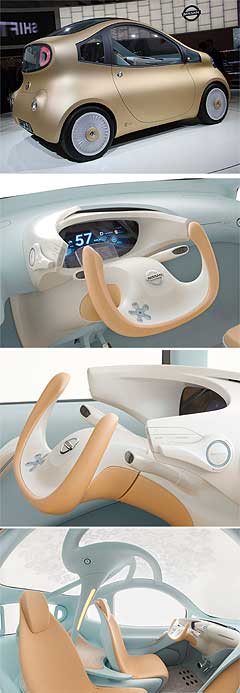First look: Nissan looks through a Nuvu at Paris
BY DAVID HASSALL | 8th Oct 2008

The weird-looking Nuvu is just 3.0-metres long and was created by Nissan's maverick design group called Creative Box, an independent group that operates from the funky Harajuku area of Tokyo, away from the constraints of Nissan’s corporate HQ.
While it may not be intended for production in this form, under the skin is the drivetrain that Nissan will use when it launches a production electric car in Japan and the US in 2010 and the rest of the world two years later.
The car's unusual name came about because the car represents Nissan's “new view” into the automotive future, which involves many more city cars that will be necessary if the world's cities are to survive and for mankind to retain the level of personal mobility it currently enjoys.

It has a driving range of only 125km and, while no output figures were provided for the rear-mounted motor, the car has a stated top speed of 120km/h and the batteries have a capacity of 140 Wh/kg (watt-hours per kilogram).
Nissan developed its laminated lithium-ion batteries with NEC and claims they have fewer components and produce 1.5 times more power than conventional lithium-ion batteries while being half the size.
The company also claims improved cooling efficiency and longer life while the compact size allows the batteries to be mounted under the seats and the vehicle’s flat floor, keeping the centre of gravity as low as possible.
But Nissan's chief of exploratory and advance planning, Francois Bancon, said that the Nuvu's interior is also very significent because it features unusual materials and a 2+1 seating arrangement.
“There is a new generation coming up who, finally, are questioning why we do the things we do. They are asking themselves, for example, why they are buying a large car when they know that for 99 percent of the time they will be in it on their own,” said Mr Bancon.
“It is our job to provide personal transportation that is better suited to people’s needs and to what the environment – in all senses – can cope with.
“We did a great deal of research into how people use their cars in the city. We found that for 90 percent of the time, the driver was alone. For five percent of the time there was one passenger and for four percent of the time there were two passengers. You can do the math to find out how often four or more people were in the car.
“We gave the second seat much more room than normal because when you take one passenger in your car it is usually someone you love and you want to make sure he or she is being carried in outstanding comfort.” Cabin layout places the regular passenger seat beside but largely behind the driver’s seat, allowing the passenger to stretch out. Ahead of this seat is a third occasional hammock-style chair which, when not in use, is folded away into the dash.
Most of the interior materials are natural, organic or recycled and the driver controls are as simple as possible, with all the major functions – steering, braking, transmission and throttle – operated ‘By-Wire’.
The steering is controlled by an aircraft-style steering yoke. With just one turn from lock to lock, the steering is very direct for agility and maneuverability in the city and the turning circle is just 3.7 metres.
Nuvu is 1700mm wide and 1550mm tall and rides on a 1980mm wheelbase with 165/55 tyres mounted on lightweight, almost transparent, 16-inch wheels.
“The people who will be drawn to a car like Nuvu are many and varied,” said Mr Bancon. “It is a cross-generational car and not a signature vehicle for one generation.
“There will be common threads, however. They will be early adopters but more importantly they regard themselves as urban citizens. They don’t just work or live in the city they are part of the city. They want a car that somehow expresses who they are and which reflects their personal ideology.
“Nuvu is a concept car, for sure, but it is an entirely credible vehicle. It is light, clean and easy to drive. It is practical and a sensible size, yet it is also embodies an element of fun: the future doesn’t look so bad, after all.”